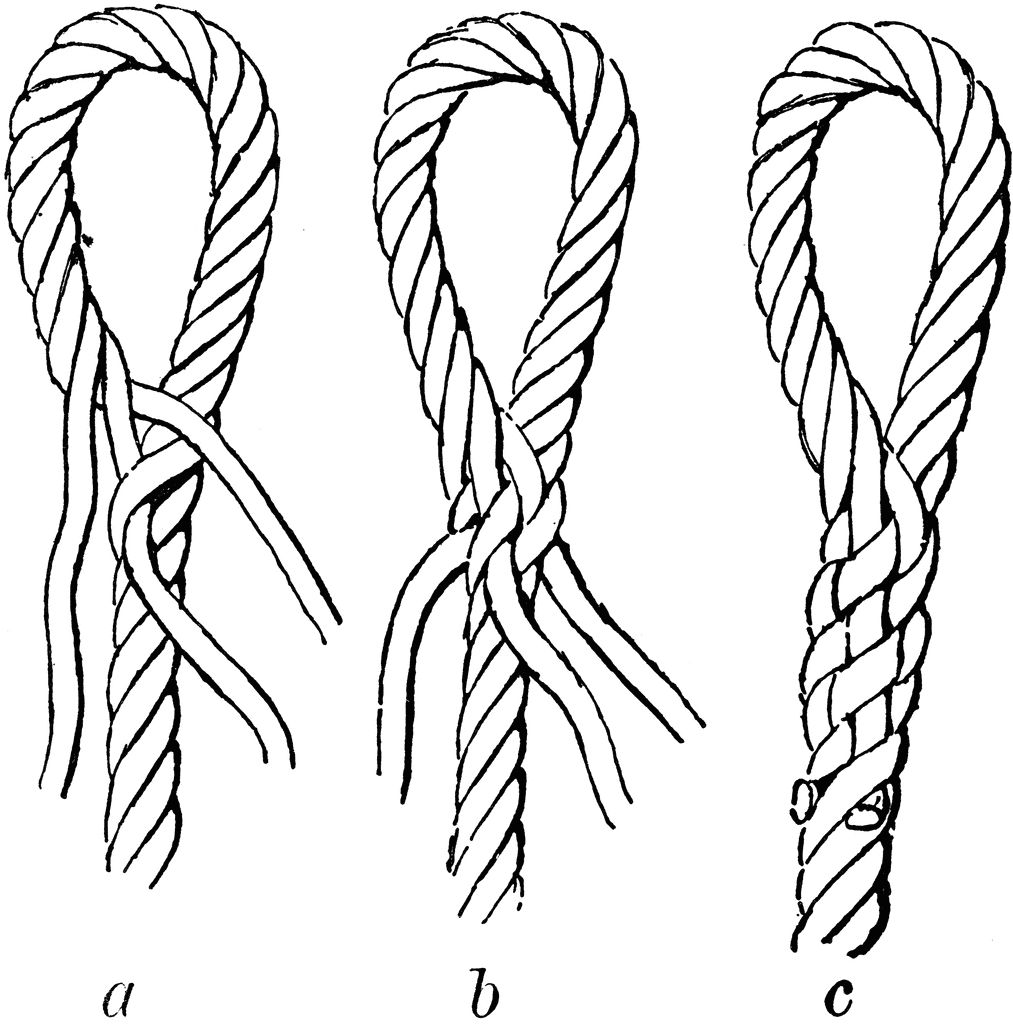

Be sure to tuck each strand pair down the same crown strand line, try to keep twist in each pair, and continually remove slack from each strand pair after tucking. Now complete two more sets of tucks with each taped strand pair.Remove tape wrap at mark A and gently but firmly pull on each of the strand pairs so mark A is now snug to the base of the eye mark B.With remaining pair strands "4", "5", and "6", select a crown row for each pair and make one tuck.Now tuck pair strands "2" and "3" in the same way with each pair, select crown row and tuck the individual pair over one strand and under two strands.Once tucked, pull out slack in strand pair "1". Starting with strand pair "1", select a row of crowns down the axis of the rope and tuck the pair "1" over one strand and under two strands.I don't know the manufacture of the OP's rope is, but at 14mm 12 strand, I'd be surprised if you couldn't use either a Brummel splice or a Samson class ll splice, both of which in my experience are much faster and easier than a tuck splice.NOTE: Rope braid pattern forms a line of strand crowns running parallel to the axis of rope. If you need conformation of the above check out the manufacturer websites. I've never used Amsteel Blue, but the class ll splice looks a lot easier the a tuck splice method, which I've found very time consuming.

Samson recommend a 12-STRAND CLASS II splice for Amsteel and Amsteel Blue, this is not a Brummel splice, but you bury the bitter end inside the standing part of the rope without the locking tucks of a Brummel splice, the buried part is tapered and the whole length of the tapper is stitched with a locking stitch. I've also used a brummel splice in 14mm round ropes designed for moorings, although I can't remember the manufacturer. I've successfully spliced polysteel in 12mm and 18mm sizes for mooring ropes, using a Brummel splice. Marlow make polysteel in the following sizes:ġ2mm 18mm 22mm 24mm 28mm 32mm 36mm 40mm 44mm 48mm 52mm 56mm 60mm 64mm 68mm 72mm 76mm 80mm 88mm 96mm In the larger sizes this can get difficult though, in that case the rope can also be spliced with a 12 strand tuck splice method." a kind of tucking technique somewhat similar to how ordinary 3-strand is spliced. "The 12 strand polysteel can be spliced by the Brummel splice as you would for a 12 strand Dyneema type rope. I need to make an eye splice around a thimble at the end of a new 14mm. Out of interest, I asked Marlow's technical department what kind of splice they'd recommend for 12 strand polysteel, here's their answer, from their technical manager. I've used 12 strand for many functions on my boat and have literally dozens of Brummel splices, including one in the Dyneema D12 main halyard. Getting a tight fit round the thimble is the trickiest part, and I found using temporary whippings to hold the thimble inplace a useful method.Ī good whipping around the throat (sounds a bit harsh!) is essential if the thimble is likely to see off axis loads, and a few stitches down the section of the rope where the bitter end is buried, gives a bit of extra security, especially if the spice is going to vibrate under no load.

The second form where you only have access the the bitter end, is marginally more difficult.īoth splices are much easier if you have access to tubular fid, or a bit of pipe of the correct diameter, which make it much easier to slide the bitter end of the rope down the middle of the standing part, look for YouTube videos and it'll become much clearer. I'd recommend a Brummel Splice in 12 strand, it's not hard to do, there are two forms depending on whether you have access the standing part of the rope or not. You are likely fortunate, in that being in Sweden, the best tools for this job - 'Swedish Fids' - are probably much cheaper there than here. There are several different forms of whipping, and again these are shown via YouTube. Once you have inserted the wanted thimble and pulled very tight - and put on a couple of G-clamps or similar to hold the 'very tight' - then do the square locking stitches.įinally, finish off with a tight whipping in polyester cord to hold the 'throat' secured. In your case I'd recommend acquiring, say, 3 metres or so of identical rope and doing a practice splice on each end. There are other approaches, including the 'Brummel locked' technique, and all benefit from previous experience. The splice begins at the wrap of tape on the rope, so this marks the closing point. I'd suggest the SECOND of the two techniques you have linked above is suitable for your purpose. Form a loop in the rope the size you want the eye. Here's one of them - with others listed ( on my screen ) down the side. You may have found them, but in case not, splices for many ropes and tasks can be found on YouTube.


 0 kommentar(er)
0 kommentar(er)
